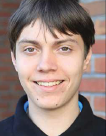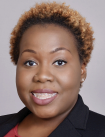Cochairs Discuss Plans for Student and Young Professionals Committee
This month, The Justice, Equity, Diversity, and Inclusion Corner is spotlighting the incoming cochairs of the Student and Young Professionals Committee—Robert Tumasian III and Lydia Gibson—and asking them a few questions about themselves and their visions for the committee in 2022.
The JEDI Students and Young Professionals Committee will provide an opportunity for students and young professionals (within five years of their highest degree) to gather and discuss their JEDI-related experiences and concerns.
Want to become a JEDI? Join ‘The Force.’ Questions? Email the group.
 Robert A. Tumasian III completed his undergraduate studies in applied mathematics at SUNY Geneseo and has contributed to several collaborative statistical projects at Emory University, Harvard University, and the National Institutes of Health. After finishing graduate school, Tumasian plans to join the US Food and Drug Administration.
Robert A. Tumasian III completed his undergraduate studies in applied mathematics at SUNY Geneseo and has contributed to several collaborative statistical projects at Emory University, Harvard University, and the National Institutes of Health. After finishing graduate school, Tumasian plans to join the US Food and Drug Administration.
 Lydia Gibson is a first-year, master’s-level graduate student at California State University, East Bay. She is also the vice president and cofounder of the Cal State East Bay ASA Student Chapter. In her free time, Gibson enjoys reading, watching standup comedy, and listening to podcasts.
Lydia Gibson is a first-year, master’s-level graduate student at California State University, East Bay. She is also the vice president and cofounder of the Cal State East Bay ASA Student Chapter. In her free time, Gibson enjoys reading, watching standup comedy, and listening to podcasts.
When did you join the ASA and why? Are you affiliated with any ASA sections?
Robert: I joined the ASA last September to build connections with government and industry statisticians, keep up to date with advances in the field, participate in conferences and other professional development workshops, and identify potential career opportunities. I also received the Lester R. Curtin Award to participate in the 2021 Conference on Statistical Practice, which compelled me to get more involved in the ASA. I am a member of the Biometrics Section, Biopharmaceutical Section, Government Statistics Section, and Section on Statistics in Genomics and Genetics.
Lydia: While applying to my master’s program last spring, I noticed a link for the ASA on my department’s web page. Seeing all the scholarship, internship, and career resources the ASA provides for students was the main reason I joined.
That August, I attended the 2021 Joint Statistical Meetings at the discounted student registration rate and learned more about the ASA; its various chapters, sections, and outreach groups; and other statistical associations such as the Institute of Mathematical Statistics and Caucus for Women in Statistics.
During JSM, I attended a mixer for the Section for Statistical Programmers and Analysts (SSPA) and have continued to attend SSPA meetings throughout the past year. Through their student travel grant, SSPA subsidized my attendance to the 2021 Women in Statistics and Data Science Conference last October, where I was able to meet more extraordinary statisticians, biostatisticians, and data scientists.
Throughout my first semester of graduate school, I have gained valuable insights from the SSPA’s career webinar series, including “Landing Your Dream Job in $tatistics and Data $cience” and “How to Choose a Career Path in Statistics/Data Science.”
Why are you pursuing a degree in (bio)statistics? Was this always your plan? If not, what changed your mind?
Robert: I have always been captivated by the complexities of mathematics and the medical sciences. When I started my undergraduate studies at SUNY Geneseo, I was a math and chemistry double major on the premedical track, since I was interested in becoming a plastic surgeon. However, after observing several procedures during a fellowship in Portugal, I learned this route was not the best fit for me. I also did not want to abandon mathematics, so I started searching for a field that merged math and biomedical science. After being invited to an outreach conference at Harvard University, I discovered biostatistics—an exciting area that combines my two greatest passions.
I am devoted to a career in statistical drug research. After graduate school, my goal is to join the US Food and Drug Administration (FDA) to strengthen the drug evaluation process and advance regulatory science from a statistical perspective. I also intend to continue developing and using computational methods to accelerate clinical research and the delivery of safe and effective treatments to individuals in need.
Furthermore, I would like to contribute to enhancing inclusivity in clinical trials, one of the FDA’s primary initiatives, which is similar in scope to JEDI’s mission. Increased accessibility to clinical trials for underserved populations can be achieved by restructuring trial designs, expanding eligibility criteria, and modifying recruitment methods, and I plan to participate in these vital efforts.
Lydia: My introduction to statistics was in 11th grade, while participating in my school’s science research program. My research partner and I worked with a professor at Adelphi University on his research, so to better understand the research methodology, we were given the option to take AP Statistics, which unfortunately met at 6 a.m. during zero period. Although I decided not to continue on with AP Statistics (6 a.m. was entirely too early for my teenage self), my interest had been piqued, so I took several statistics courses while completing my undergraduate degree in economics, including elements of statistics, business statistics, economic statistics, and econometrics.
I have always loved math, AP Calculus having been my favorite course in high school, but I found that statistics—more so than other areas of mathematics—is applicable to all real-world problems, no matter what industry or field you pursue.
I am originally from Long Island, New York, but having lived in Silicon Valley for almost seven years now, I’ve realized there is more to the tech industry than just software engineers, IT specialists, and computer programmers. There is also an abundance of statisticians and data scientists. It was never really my plan to pursue an advanced degree in statistics, but I believe my degree program will help me make the career change into tech.
Why did you join JEDI, and what do you hope to accomplish in this role?
Robert: I hope to contribute to eliminating inequities faced in statistics, and I am looking forward to collaborating with Lydia and other JEDI members to design and provide enrichment opportunities for students and early-career professionals.
I am also excited to connect with various ASA affiliates and act as an intermediary to ensure clear communication and transparency between students and ASA executives. I want to maintain strong partnerships between the ASA and external entities, and I hope to forge alliances with additional organizations, like the FDA, to fuel the growth and success of students and the ASA.
Furthermore, through working with students and staff from multiple institutions, I would like to assist in the development of curricula that foster diverse and welcoming learning environments and encourage students to advocate for their needs. I would also like to compile a repository of scholarship and fellowship opportunities for underserved groups in statistics and share it on the ASA website.
Lydia: At the beginning of the 2021 JSM student mixer, Kimberly Sellers, the inaugural chair of the JEDI Outreach Group, gave a presentation outlining the goals and initiatives of JEDI. Realizing they aligned with my own values, I knew this was a group I had to join.
That September, with only 15 minutes to spare before my classes started, I briefly attended JEDI’s student town hall to further express my interest in becoming a member of the Student and Young Professionals Committee. I had also just joined my department’s diversity, equity, and inclusion action team, so I was really excited to contribute what I’ve learned in each group to one another.
How can you serve as a resource for students?
Robert: I am always happy to discuss (bio)statistics PhD programs and ideas to increase ASA membership. Additionally, I can provide information about funding opportunities for school or research and scholarships to participate in ASA conferences. I am also available to review and provide feedback on application essays. I can be reached anytime by email.
Lydia: I really want to get more students engaged in JEDl and the ASA, especially undergraduate and master’s students. I would like to help facilitate the formation of ASA student chapters and encourage a more diverse array of students to join the ASA by showcasing the benefits of student membership.
I will be a resource for students by pointing them in the direction of useful tools and information about career preparation, internships, scholarships, job applications, and research/fellowship opportunities.
Any of my classmates will tell you I am invested in the success of others, and I want to continue on with that through JEDI. If there is any matter related to JEDI or the ASA that I can help with, my inbox is always open.

















